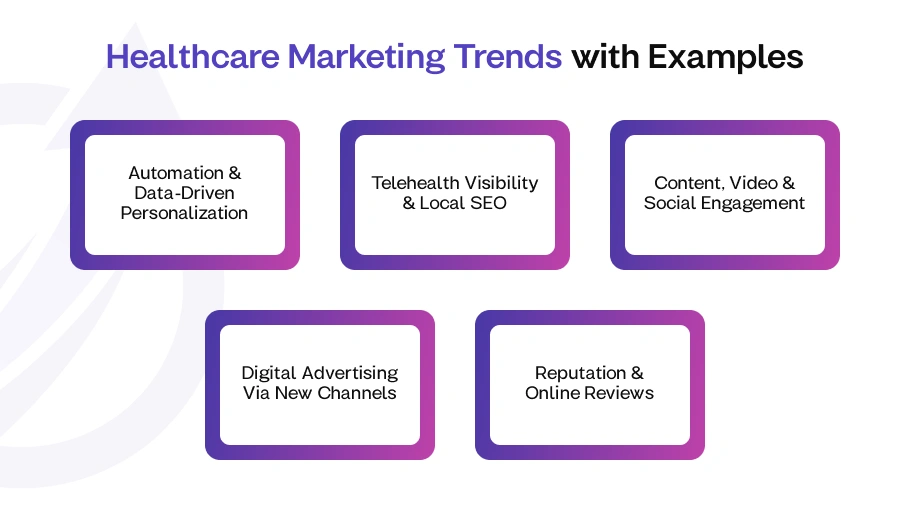Medical practices are witnessing a fast-developing change in healthcare marketing trends in 2025. The global digital health market is projected to reach $1.5 trillion by 2032, indicating huge growth in digital healthcare services. With the booming online healthcare services, the corresponding advertising budgets are rising too. The global healthcare ad market was $42.3B in 2024 and is expected to grow at 5.4% annually to $67.9B by 2033 .
Understanding marketing trends in healthcare is key to adapting effectively. In this post, we discuss the top healthcare marketing developments in 2025, with digital marketing strategy examples used by clinics and hospitals.
Top Healthcare Marketing Trends 2025
Here are some advertising trends that healthcare marketers have implemented in 2025:

1- Automation & Data-Driven Personalization
Healthcare marketers are using data and artificial intelligence (AI) to customize their outreach. Predictive analytics can spot patterns like no-shows or care gaps and trigger timely reminders. Campaigns that use a patient’s history and preferences perform better. Chatbots and virtual assistants are also on the rise, with practices using chatbots for customer-facing tasks.
Many practices also use healthcare marketing automation tools to ensure smoother messaging. Automation tools help clinics do more with less. CRM and email platforms are sending appointment reminders, follow-up instructions, or birthday greetings with no manual effort.
Importantly, healthcare providers use tools built for privacy. Automation in healthcare marketing platforms with HIPAA compliance encrypts data and requires patient opt-in for communications. This means clinics are safely automating routine outreach while maintaining trust and meeting regulations.
Example
Oak Street Health, an old-age care provider based in Chicago, has applied data analytics and targeted digital tactics to reach Medicare-age patients, effectively turning clinical data into acquisition and retention campaigns. Their approach is a clear example of using automation and analytics to run hyper-targeted, high-ROI marketing to specific patient segments..
2- Telehealth Visibility & Local SEO
As care shifts outside hospitals, marketing must meet patients locally and virtually. Telehealth is now expected in many specialties. Marketers should clearly explain what virtual services are offered and how to access them. Local search optimization remains mission-critical: when patients search “dentist near me” or “urgent care open now,” an updated Google Business Profile helps practices appear in local results.
Clinics should highlight local advantages, such as short wait times or bilingual staff, and run hyperlocal campaigns. These local-first tactics align with broader healthcare marketing trends , ensuring patients in your area find your services first.
Example
Leawood Total Wellness Center, the healing and wellness clinic, aimed to enhance its patient acquisition by improving visibility in local search. They targeted specific keywords, such as “hormone therapy in Kansas City” and “bioidentical hormone replacement therapy near me.”
As a result of the localized SEO strategy , the campaign achieved 44,500 impressions and generated 1,020 clicks, ultimately leading to 38 new patient inquiries or sign-ups over two months.
3- Content, Video & Social Engagement
Educational content builds trust and boosts visibility. Providers can publish blog posts, infographics, or videos that answer patient questions. Video is especially effective: doctor introduction clips, live Q&A sessions on seasonal health topics, or facility tours help humanize the practice and reduce patient anxiety.
Social media is also a key channel. Practices should share concise, helpful content on Facebook, Instagram, or YouTube to engage their community. Patient stories, behind-the-scenes glimpses, and expert Q&As can increase engagement. Collaborations with trusted medical influencers also expand reach.
The above content-driven strategies support a broader approach to digital marketing for healthcare by educating patients and keeping them informed. Educational content and social engagement are core healthcare marketing trends that reshape patient outreach.
Example
Blush Fitness, a full-service women's health club in Kansas City, required a contemporary, female-focused campaign to enhance its membership base. To address this, their marketing team developed targeted video advertisements along with social media campaigns tailored to resonate with women in Overland Park.
As a result of their efforts, the campaign achieved an impressive 3.52 percent click-through rate, driving 33 free day pass sign-ups from potential members interested in experiencing the gym. Ultimately, their initiatives led to 259 new membership sign-ups through effective social media marketing.
4- Digital Advertising Via New Channels
Providers are expanding digital ad budgets. Search ads on Google, including AI-powered campaigns, remain popular for booking appointments, but savvy marketers use a mix of channels.
Moreover, voice search optimization and newer marketing options, like reels and social media storytelling, are effective. Combining search, social, and targeted content helps reach patients at multiple touchpoints. For healthcare providers, embracing these healthcare marketing trends can lead to meaningful growth.
Example
A prime example of effective digital advertising through new channels is in pediatric dentistry. Dr. Austin Millz, popularly known as @the.dentistmom. She captivates audiences with her Instagram Reels that provide essential dental tips for kids, such as the clever “how to brush a toddler’s teeth” video.
With around 258,000 followers, her engaging and informative content has built a strong connection with parents, building community trust that extends far beyond her local practice. This illustrates the incredible potential of social media storytelling through Reels, TikToks, and live Q&A sessions to broaden reach and enhance a local clinic's brand.
5- Reputation & Online Reviews
Positive online reputation is crucial, as patients heavily rely on reviews. It can take as few as 1–6 reviews for a prospective patient to form an opinion. Practices should encourage satisfied patients to leave Google reviews and respond thoughtfully to feedback.
Clinics can also feature patient success stories or testimonials on their website and social channels. Providers build trust and attract more patients by actively managing their online reputation. Even small clinics can stand out by earning five-star reviews and engaging with their community online.
Example
Healthpointe, a multi-location provider of occupational and sports medicine in Southern California, generated patient reviews through on-site kiosks and email invitations. The provider aggregated feedback across various review sites, successfully improving their average rating from approximately 3.3 to 4.8 stars, and proactively managed negative reviews.
In just 12 months, Healthpointe garnered over 15,000 new reviews, enhancing its online reputation and subsequently leading to increased SEO traffic and patient acquisition from Google searches.
Putting Trends into Practice
Staying on top of healthcare marketing trends means combining technology with empathy. Providers that use AI-driven personalization, local SEO, engaging content, and smart online ads can better connect with patients who expect convenience and clear information. Throughout, keeping patient trust and privacy is vital. This is where Prime Cloud Care can help!
Prime Cloud Care stays on the cutting edge of these trends. We help practices implement modern marketing tactics, customizing a digital marketing strategy for healthcare that uses local SEO, targeted ads, and engaging content to grow your patient base.
Contact us to see how we integrate the latest advertising trends into your practice’s marketing strategy.
FAQs
Digital marketing helps healthcare organizations reach patients where they spend most of their time online. In 2025, digital strategies will improve visibility, build credibility, and help providers compete locally by offering accurate, accessible, and patient-focused information.
Advances in technology, changing patient expectations, evolving insurance and care models, and competition all shape healthcare marketing trends.
It’s a strategic roadmap that outlines a practice’s marketing goals, target patients, messaging, and channels, such as the website, social media, and email, to attract and retain patients.
Tools and software that automate marketing tasks like appointment reminders and patient follow-ups in a HIPAA-compliant way, enhancing efficiency and engagement.
Strategies include SEO, content marketing, social media engagement, email marketing, and online advertising. These tools help practices educate patients and drive appointments.



